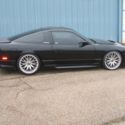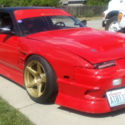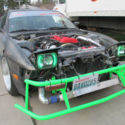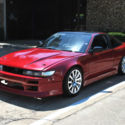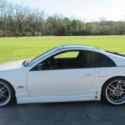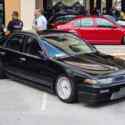1990 RHD Nissan 240 SX Turbo SR20DET fast and furious drift car 5 speed JDM RARE
| Make: | Nissan |
| Model: | 240SX |
| Year: | 1990 |
| Mileage: | 98321 |
| VIN: | JN1HS36P5LW107892 |
| Color: | Red |
| Interior color: | Gray |
| Drive side: | Right-hand drive |
| Vehicle Title: | Clean |
| Item location: | Seattle, Washington, United States |
1990 Nissan 240SX Additional Info:
NO RESERVE>>>>>>>>>>>>>>> NO RESERVE>>>>>>>>>>>>>>NO RESERVE>>>>>>>>>>>>No ReserveI have a very rare very fast RHD Japanese Nissan 240 SX for sale 5 speed manual turbo engine with all the bells and whistles making this a very powerful fast and furious type drift car.
It is modeled off of the Japanese 180 X, the engine is the desirable turbo charged model..
I got this in a trade deal so I'm selling this at a very very cheap price!
It has a clear title runs drives and stops!It has NO rust,never been hit all body parts are all original a true survivor!
Let someone else take it to the next level it is being sold as is with NO RESERVE
This comes with the dura flex dress up kit that is not installed plus many other parts.This car was set up to race so the back seat and other various inside things were removedThis car is to nice to part out,it is a good chance to get a real Japanese collectible sports car at a cheap price
If your looking for a fast street legal RHD Japanese import luxury classic sports car then this is it.Call 206 817 8387 with questions DO NOT TEXT
What has been done and on this car now!
180 X Replica Kit
CX Racing Intercooler
CX Racing Aluminum Radiator
Megan Racing Fully Adjustable Suspension
3 inch Straight pipe
300 ZX Calipers
Drilled and slotted Rotors
Digital Gauges
Kouki Tail lights
Momo detachable Steering Wheel
Nizmo Wheels From Japan
Forged internals (crankshaft and connecting rods are forged making it stronger than normal)
To much to list.Cuurent values of the 240SX and 300ZX
- Share
Prefer doing business in person?Connect with an agent in your area
Jump To:- Current & Historical Values
- Past Sales
- Vehicles for Sale
- VIN Decoder
- Articles & Videos
Image is general in nature and may not reflect the specific vehicle selected.
History of the 1990-1996 NissanDatsun made its reputation with its Z cars, launched in 1970 with the 2.4-liter 240Z sports coupe. The company followed the 240Z with a string of successes, including the 260Z and 280Z. The product line became decidedly more middle-aged at the end of 1978 with the arrival of the GT- and comfort-oriented 280ZX, so Nissan brought the Z car back to a more sporting model with the U.S. introduction of the 300ZX in 1984.Known internally as the Z31, the initial Nissan 300ZX would run until 1989. And while the Z31 was an evolutionary extension of the original Z line, the new Z32 iteration of the 300ZX, introduced in 1990, was more of a new beginning. The 1990 300ZX was one of the first cars designed with computer software and featured a host of innovations, including optional four-wheel steering in the turbo versions.
The 3.0-liter engine was the only element handed directly down from the Z31 to the Z32 and even that was revised with variable valve timing and dual overhead camshafts. This new configuration produced 222 hp in normally aspirated form. Most noteworthy was the Turbo model, which was upgraded with twin turbochargers and intercoolers. The 300ZX Turbo now wrung 300 hp out of the 3.0-liter mill, had a top speed of 155 mph, and could sprint to 60 mph in fewer than 6 seconds. Independent suspension on all four wheels ensured handling was superb as well.
On the outside, the 300ZX was strikingly new. Sleek, slinky, and less angular, the car was an attractive and cohesive modern design. Front and rear bumpers were better integrated into the car’s lines, and subtle fender flares and a purposeful stance hinted at the car’s performance potential. With looks to match the drive, critics instantly fell in love with the car and lauded it throughout its seven-year U.S. run.
In 1993, a convertible was presented for the first time in the Z’s history, though most cars were configured with T-tops. The 300ZX was discontinued Stateside in 1996, as the car’s sticker price rose and American tastes shifted towards SUVs. It would be another seven years before the Z name was revived in America in the 350Z.
Nissan’s Z32 300ZX doesn’t have a sizable following today even though it has a fantastic reputation. This can mostly be attributed to the car's relatively young age. For collectors, this is good news as prices remain low, and the fun-per-dollar quotient is just about as good as it gets. Being a modern car, though, the 300ZX doesn’t have same aura as older cars, and it also has plenty of electronics that can be expensive to fix. Like any older car purchase, it pays to perform a thorough inspection and to find an example with lots of documented history.
">Datsun made its reputation with its Z cars, launched in 1970 with the 2.4-liter 240Z sports coupe. The company followed the 240Z with a string of successes, including the 260Z and 280Z. The product line became decidedly more middle-aged at the end of 1978 with the arrival of the GT- and comfort-oriented 280ZX, so Nissan brought the Z car back to a more sporting model with the U.S. introduction of the 300ZX in 1984.
Known internally as the Z31, the initial Nissan 300ZX would run until 1989. And while the Z31 was an evolutionary extension of the original Z line, the new Z32 iteration of the 300ZX, introduced in 1990, was more of a new beginning. The 1990 300ZX was one of the first cars designed with computer software and featured a host of innovations, including optional four-wheel steering in the turbo versions.
CURRENT & HISTORICAL VALUESView current vehicle values and see how they’ve changed over time in a 3-year, 5-year and to-date intervals. Compare these values to other vehicles and benchmark financial indices.Current Values
- #1 Concours$60,300Condition #1 vehicles are the best in the world. The visual image is of the best vehicle, in the right colors, driving onto the lawn at the finest concours. Perfectly clean, the vehicle has been groomed down to the tire treads. Painted and chromed surfaces are mirror-like. Dust and dirt are banned, and materials used are correct and superbly fitted. The one word description for #1 vehicles is "concours."
- #2 Excellent$25,900
- #3 Good$16,500
- #4 Fair$6,200
-15% for Automatic
- About Hagerty's Condition Ratings
- |
- About Our Prices
- 3 YEAR
- 5 YEAR
- ALL













